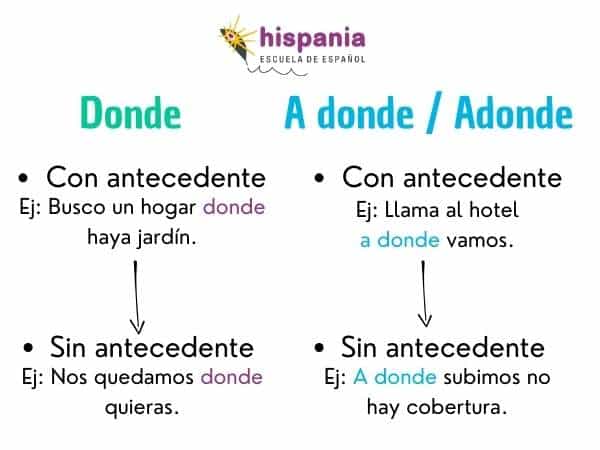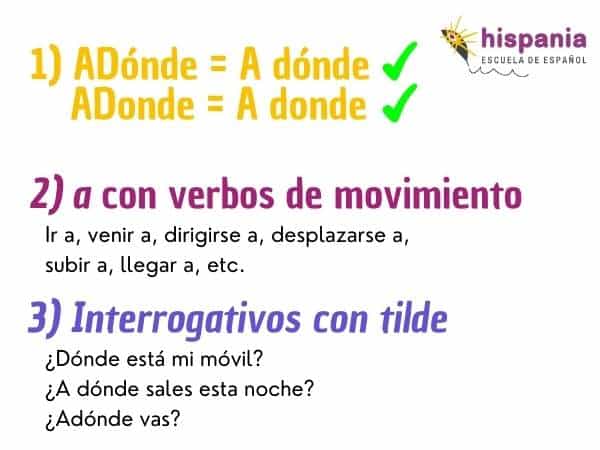
Differences between where, where, where, where, where and where
The word where It is very important in the Spanish language. It's a adverb that expresses place.
Now, why does it sometimes have an accent and other times not? And why does it sometimes have the preposition a in the same word and others separately?
Surely you have asked yourself these questions more than once. Well today you are in luck. All these doubts will be resolved in this article.
We are going to explain to you how the adverb works where in all possible situations.
It will be a very advanced grammar article, intended for studyianSpanish lessons with a intermediate – high level.
Would you like to delve deeper into Spanish grammar at a top level? Then you need to come to our Spanish courses en Hispania, escuela de español.
In these classes you will learn everything you need to be able to communicate in Spanish in real life. All in a sociable and happy environment.
Where are you going to find a better place to learn Spanish?
Surely nowhere. Speaking of where, we said that we were going to talk about this adverb, right?
Well come on, let's hit it!
First let's explain to you where, where y where to with tilde

Where, where, where: Interrogative and exclamatory adverbs
When adverbs where, where o where to have a tilde, they are about interrogative or exclamatory adverbs.
That is, they are used to ask or show emphasis.
Let's look at the meaning of each word separately.
Where: In what place
Generally, the adverb where with tilde means where in.
Used to ask or exclaim where the action is done.
For example:
- ¿Where Are you planning to spend your vacation this year?
- ¿Where you found that book so interesting
- ¿Where you currently live
- ¿Where Did you learn to play the guitar so well?
- I can't see you. ¡Where are!
These movies are interrogative and exclamatory sentences whether they are Direct. That is, they have question marks and exclamation marks.
Similarly, it’s also true that online learning has There are interrogative and exclamatory sentences. indirect. These are made in the middle of an affirmative sentence and do not carry the signs.
However, adverbs maintain their accent because they are still considered interrogative and exclamatory.
For example:
- I'm curious to know where You found that amazing deal.
- I would like to discover where You learned to play the guitar so well.
- I wonder where I'll get a copy of that interesting book.
Where / To where: To what place
Just like where to such as, where are two correct and they are used for the same thing. Both ask or exclaim the place to which the action is directed. (which place).
They always go with movement verbs that carry the preposition a.
The most common verb is go to, but there are many more: get on, head to, drive to, carry to, travel to, move to, etc.
These verbs are also considered direction or destination verbs, and they always carry the preposition a.
For example:
- ¿Where to does this elevator go up?
- Stay still. ¡Where to you go!
- ¿Where Did your friends move recently?
- ¿Where will you take your guests?
- ¿Where to lead this road?
As you see, in the examples we have used where to y where indistinctly. They work just as well.
Of course, be careful and don't use the verb 'estar' with the preposition a. It's a common mistake people make, but 'estar' never carries a to talk about places:
- ¿Where is it your brother? ❌
- ¿Where is your brother? ✅
We can also do indirect questions are dealt with first, followed by where to y where:
For example:
- I dont know where your thoughts are lately.
- I would like to discover where to your old neighbors moved away.
- I'm curious to know where to takes this path.
These sentences They do not have question marks because they are not made with the tone of a question, but they are also considered as interrogative sentences.

Where, where, where: Relative adverbs of place
Now we are going to explain to you when they are used where, where o where to without tilde. The three are relative adverbs of place.
These relative adverbs introduce subordinate clauses.
Subordinate clauses serve to give descriptions or new actions that are related to the main clause.
Let's see all the situations in which we can use where as a relative adverb.
Uses of where
Where such as, relative adverb of place can be used in many ways. We list them all:
With antecedent referring to a place
El antecedent would be the place of main sentence about which we are going to give new information in the relative clause.
For example:
- Roberto is looking for a restaurant where they serve vegan food.
- Sara lives in a neighborhood where there are hardly any cars.
- Carmen studies at a school where many cultural activities take place.
La blue sentence is the relative.
What is the background of the above examples? The places that are marked in the main sentences: a restaurant, a neighborhood and a school.
If you look at the previous examples, the first sentence has the subordinate verb in the subjunctive. However, in the other two, the verb is in the indicative.
Because? It is important that you know this.
When the subject of the main sentence know the background, the verb of the relative clause goes in indicative.
In the examples, Sara lives in a neighborhood she knows and Carmen studies at a school she knows. Therefore in indicative.
On the other hand, if the subject does not know the background, the verb of the relative clause must go in subjunctive mood.
In the first example, Roberto is looking for a restaurant, therefore it means that he does not know it yet. That is why the verb of the relative clause is put in the subjunctive: serve.
Is it clear? It is very important that you understand this!
Another interesting thing to keep in mind is that, when we have an antecedent, the relative adverb where also can be substituted by the following:
- In which, in which, in which, in which.
- In which, in which, in which, in which.
- In what.
The sentences from before with these adverbs would be like this:
- Roberto is looking for a restaurant in which They serve vegan food.
- Sara lives in a neighborhood in which there are hardly any cars.
- Carmen studies at a school in which many activities are done.
No precedent
We can also have relative clauses with the adverb where no precedent.
We put it right after the verb of the main sentence.
For example:
- Vivo where you live.
- Work where is the Mestalla.
- We meet where we met for the first time.
In the prayers we have where no precedent, we could replace this adverb with in the place wheree:
- We meet in the place where we met for the first time.
Somewhere where / Nowhere where
These movies are two structures they don't have a express antecedent and they usually go with verbs "haber" y have.
For example:
- You know somewhere where Is there internet near here?
- I can't find nowhere where have free parking.
Uses of where / where
Where to / where to are used with movement verbs or destination that have the preposition a.
Remember that some verbs that express the direction are dealt with first, followed by a Typical are: go to, come to, go up to, move to, move to, leave for, go to, etc.
As with the interrogative and exclamatory adverb, the two forms They are totally correct and they can be used in the same way.
With precedent
Where to y where They can go in movement sentences that have an antecedent:
- The city where are you going is beautiful.
- The clinic where I'm headed It's from my best friend.
- The place where we go is near.
No precedent
Likewise, they can also go no precedent:
- voy wherever you want.
- she always comes where he tells him.
These sentences and the previous ones could be replaced by to the place that and they would mean the same thing.
- voy to the place that you want.
Other prepositions
Furthermore, you should know that due to the circumstances of the verbs, the word where can carry other prepositions.
In these cases, we do not put the preposition a. We cannot put two prepositions together.
- Miró to where the sound could be heard. ❌
- Miró where the sound could be heard. ✅
- we'll go where the train passes ❌
- we'll go where the train passes ✅
is it possible to say where, where, from where… but never where!
Where It is incorrect, instead we simply say where.
This use of where with prepositions applies in the same way when we use where such as, interrogative adverb.

Doubts to take into account
Now you know how to use correctly where, where, where, where, where and where. Bravo! 👏🏻
As a recap, we are going to highlight again some of the most frequent doubts regarding this topic. This way it will be very clear to you.
All correct: Where and where / Where and where
Remember that the two forms with the preposition a They are completely correct, whether it is an interrogative or exclamatory adverb or a subordinate clause adverb.
Use both without problems!
Preposition a with verbs of movement
The preposition a It is only used when it goes with movement verbs that need it.
For example:
- Where did you go last night?
- I will go with you where we can be happy.
- Where will you travel this summer?
- Wherever I go, I will always remember you.
Interrogatives and exclamatives with an accent
Remember that interrogative adverbs and exclamatory They always have an accent to mark the place about which the question is asked or emphasis is placed.
- Where we are is a wonderful place!
- Where did you meet?
- Still do not know where to go Saturday?
- Well we're done.
Did it help you? It is a somewhat complicated topic, especially because of the subordinate clauses.
So take it easy and don't get frustrated.
These are difficult aspects of Spanish grammar and ideally you will take classes with expert teachers, as in Hispania, escuela de español.
Do you have any more questions? If so, don't hesitate to write it in the comments.
¡Nos vemos!
Article written by Carlos Martínez for Hispania, escuela de español.
More articles



